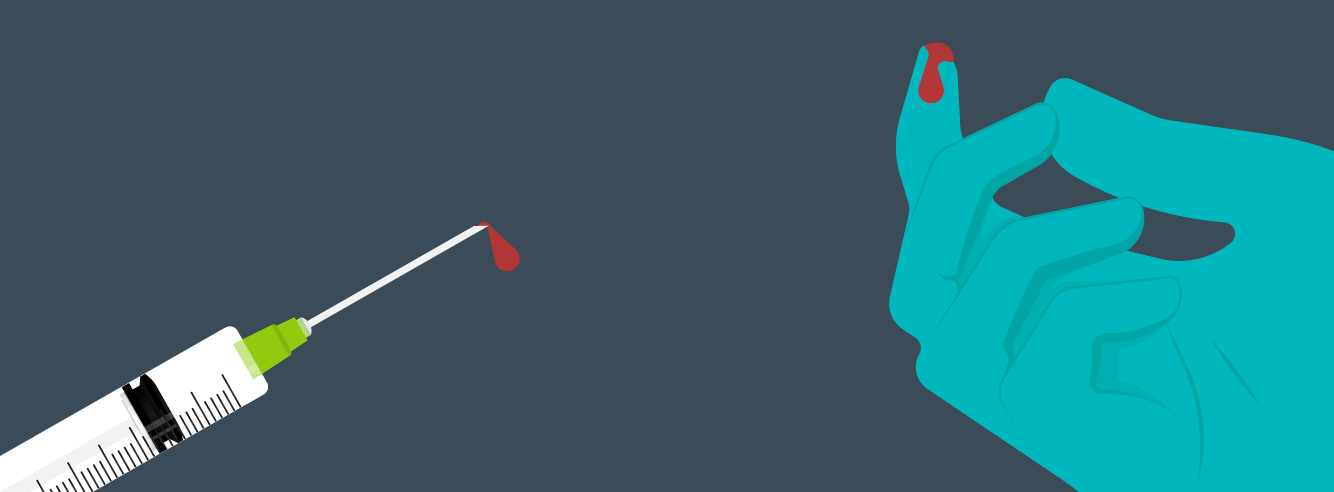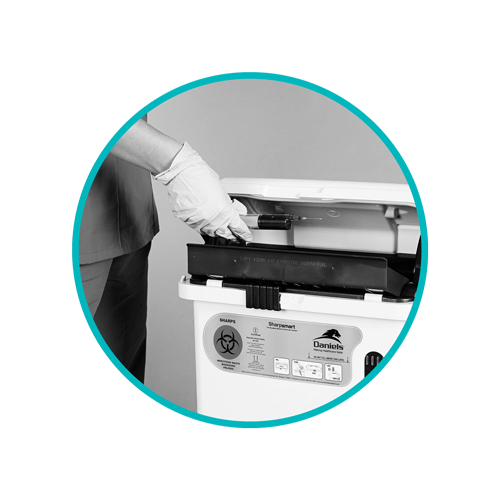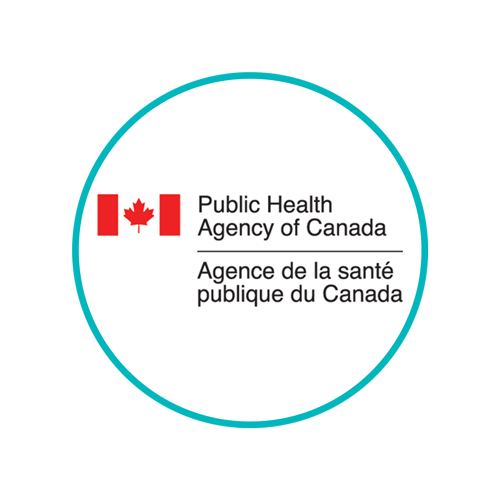Sharps Injuries: What to do if You're Stuck

How do you keep healthcare workers safe from sharps? From top leadership to nurse supervisors, everyone wants to prevent sharp injuries. But despite everyone’s best efforts, a sharp injury can happen. In fact, historical data shows that needlesticks can happen more than 69,000 times each year in Canada. These injuries can expose healthcare workers to bloodborne diseases and infections, including HIV and Hepatitis B and C.
Knowing what to do if you sustain a sharps injury at work is crucial to getting the wound treated and recorded. Additionally, proper post-exposure prevention (PEP) will help to minimise the potential for any other harmful effects. Here’s what you need to know about dealing with a sharps injury and some best practices for avoiding them.
TOPICS WE WILL COVER:
1 / How Sharps Injuries Happen
2 / How do Healthcare Providers Feel About Needlestick Dangers?
3 / What To Do After A Sharps Injury
4 / Best Practices For Preventing Sharps Injuries
5 / Protect Yourself and Your Colleagues
How Sharps Injuries Happen
The US Centers for Disease Control and Prevention conducted vigorous research over the course of 12 years with data gathered from exposure incidents. This research sheds significant light on how injuries occur and how often. The study used data from both hollow and solid sharps.
More than half of the injuries involving hollow-bore needles occurred during use. These were often during common healthcare procedures. These included accessing an IV line, passing or transferring equipment, processing samples, colliding with another worker or their sharp, and simply inserting or removing a needle. Injuries occurring after use but before disposal accounted for 19% of the injuries. Injuries that occurred while disposing of the sharp made up 22% of the occurrences.
In terms of solid sharps, 70% of injuries reportedly happened during use. These were also relatively common procedures, like handling a suture needle for routine stitches, handling or transferring a sample, and colliding with a worker handling the sharp. Injuries that happened after use but before disposal accounted for 15% of the injuries, and only 3% of solid sharps injuries happened during disposal.
In a subsequent 2015 US study, covering 34 states and 181 hospitals, it was estimated healthcare workers experience 300,000+ sharps injuries each year in both hospital and non-hospital settings.
How do Healthcare Providers Feel About Needlestick Dangers?
Healthcare providers have firsthand insight into the workplace environment and sharps injuries. In 2020, the UK’s Royal College of Nursing conducted a sweeping surgery of over 7,500 of their members to better understand sharps injuries. Their responses were revealing. 96% of members have a blood and body fluid exposure (BBFE) risk and over half (63%) have had a sharps injury in their career, with 15% experiencing that injury in the last year. Those injuries occurred at different times in the care process:
- 29% before procedure
- 26% during procedure
- 21% during disposal
-
11% improper disposal
It’s also important to understand the gaps in safety measures. 15% reported that their access to safer sharps was nil to poor and 23% didn’t have access to sharps bins nearby their work area. A quarter of the respondents reported not having training on the safe use of sharps, while 21% did not receive training on how to report a sharps injury.
What To Do After A Sharps Injury
A sharps injury can be a scary experience, but understanding how to react is crucial. Here is what you need to do if you experience skin puncture from sharps as a healthcare worker:
- Quickly scrub the puncture with soap and water. Allow the area to bleed. “Milk” the wound to push blood from the wound out of the body.
- Following initial cleaning, notify your supervisor, HR, and the Joint Health and Safety Committees.
- You will need to complete an entry in the sharps injury log. Commonly required information includes the date & time, procedure, type of sharp involved, and essential health information about yourself.
- Begin talking with the source patient to get consent for infection testing for HIV and Hepatitis variants.
- Go to your occupational healthcare provider for an immediate evaluation.
- Begin confidentially but immediately, testing for HIV and Hepatitis infections.
- Begin post-exposure prevention aligned with guidelines set out by your province’s Ministry of Health.
-
Make sure to stay compliant with all necessary records and follow-up testing requirements. You should do follow-up screenings for diseases and infections at six weeks, 12 weeks, and 24 weeks. Depending on the type of exposure, follow-up testing may be needed after one year.
Best Practices For Preventing Sharps Injuries
Many best practices can help lower the risk of exposure to sharps. The first level is making sure equipment and instrumentation has the proper engineering controls, and the second level consists of the workplace protocols that ensure the safe operation of the equipment.
Using Proper Equipment
- Sharps should have a built-in safety feature.
- Safety features should be operable with one hand.
- During use, the healthcare worker’s hands should be behind the sharp.
- Safety features should be apparent when engaged.
- The safety should not allow for deactivation.
-
The safety should continue to protect the user through the disposal stage.
Workplace Safety
- Use only safety-equipped devices provided by the employer.
- Never try to re-cap sharps.
- Have a plan for safe use and disposal before ever using the sharp.
- Always dispose of used sharps right after use.
- Only dispose of used sharps in specialised disposal containers.
- Do not overfill sharps disposal containers.
- Report sharps injuries right away.
- Always report sharps injuries to your employer and the Joint Health and Safety Committees (JHSC).
- Stay up-to-date with training and education for infection exposure and prevention.
- Get vaccinated for Hepatitis B.
-
If sharps are for educational or research purposes, stay current on your Tetanus vaccination.
Additional measures from The Centre for Communicable Diseases and Infection Control at the Public Health Agency of Canada (PHAC) include personal safety steps that individuals can take:
- Place puncture-resistant containers in an easily accessible location at the point of care.
- Workers in the healthcare field should cover open skin or lesions.
- Personal protective equipment should cover the face, including the eyes, nose, and mouth if there is any anticipation of splashing bodily fluids.
- Exposure to bodily fluids should be treated as an emergency first aid situation. In these cases, the contact site should be rinsed thoroughly and washed with soap and water. If the eyes or mouth were exposed, these should be flushed with water. If the exposure occurs to broken skin, it should also be rinsed thoroughly.
-
Report the incident right away, and follow all directives for follow-up care.

Protect Yourself and Your Colleagues
Accidents will happen, even when workers follow all needed safety measures. The most important thing to remember is to take action quickly if sharps or exposure has injured you. Sharps injuries present a significant risk of infection for workers that fail to act soon to obtain testing and care. The diseases possible include HIV, Hepatitis, fungal infections, bacterial infections, and other dangerous infectious conditions.
When cleaned and reported immediately, you will have the greatest chance of effective post-exposure prevention, but you’ll remain in compliance with JHSC directives. Quick, decisive action can reduce the chance of future dangers by monitoring the event and follow-up care, and injury surveillance will also help prevent future injuries.
